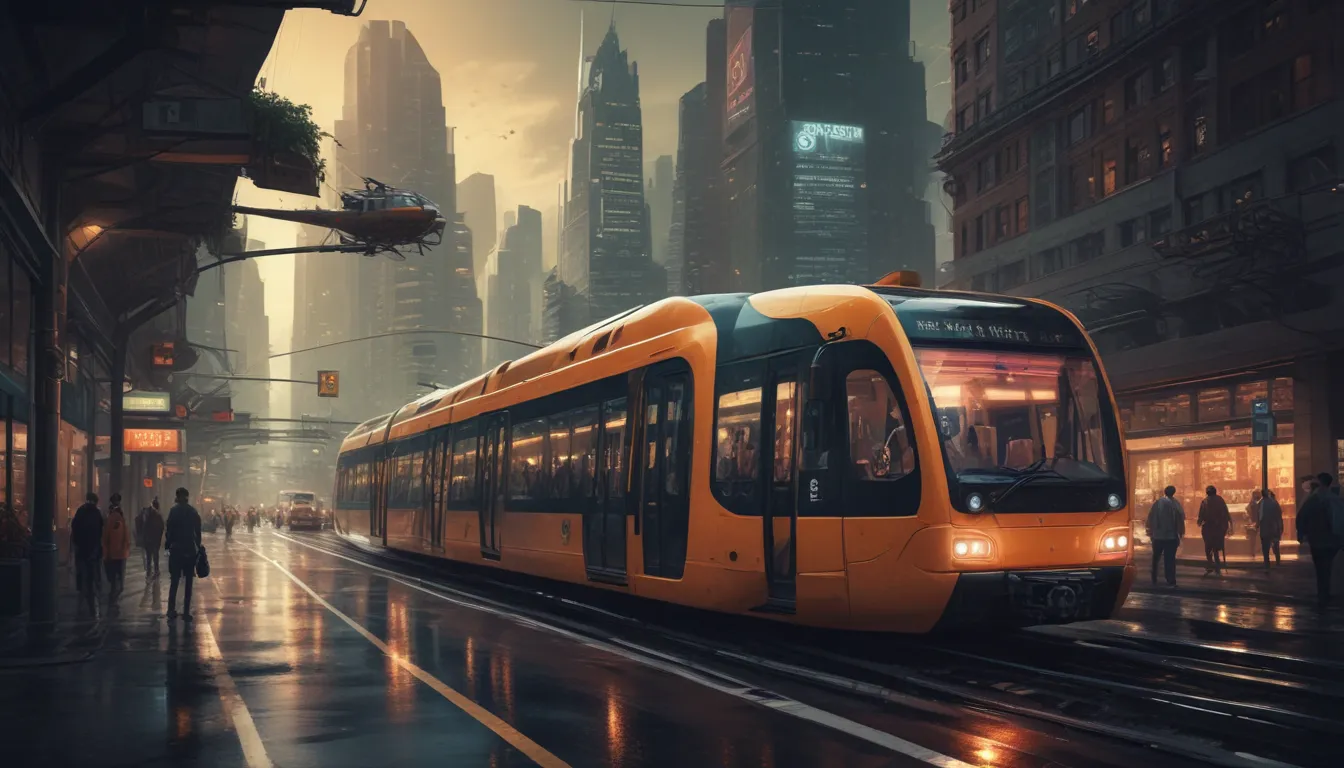A Note About Images: The images used in our articles are for illustration purposes only and may not exactly match the content. They are meant to engage readers, but the text should be relied upon for accurate information.
Are you ready to explore the exciting world of alternative transportation systems? As we become more mindful of our environmental impact and seek sustainable solutions, unconventional modes of transportation are gaining traction. While traditional vehicles still dominate our roads, innovative options like electric scooters and self-driving cars are revolutionizing the way we move from place to place. In this article, we will delve into 20 surprising facts about alternative transportation systems that will open your eyes to a greener and smarter way to travel. Get ready to be amazed as we uncover the future of transportation!
Unveiling Innovative Solutions:
- Electric scooters and solar-powered bike paths are just the tip of the iceberg when it comes to eco-friendly transportation in urban areas. These options not only reduce carbon emissions but also make it easier to navigate bustling city streets.
- From high-speed rail to self-driving cars, alternative transportation systems are transforming the way we travel, offering sustainable solutions for the future.
Electric Scooters: The Urban Trendsetter
Electric scooters have taken urban areas by storm, offering a convenient and environmentally friendly mode of transportation. These scooters are not only cost-effective but also provide a seamless way to maneuver through busy city streets with ease.
The Netherlands’ Solar-Powered Innovation
The Netherlands leads the way in transportation innovation with the world’s first solar-powered bike path. By harnessing solar energy during the day, this path illuminates at night, enhancing cyclist safety and sustainability.
Carpooling: A Commuter’s Dream
Carpooling reduces traffic congestion and carbon emissions by allowing multiple individuals to share a single vehicle during their daily commute. This simple yet effective alternative transportation system has been a game-changer in many cities.
Rediscovering Ridesharing
Did you know that the concept of ridesharing dates back to the 1940s during World War II? Carpooling was encouraged to conserve fuel and resources for the war effort, demonstrating the long-standing benefits of this transportation method.
Embracing Bike-Sharing Programs
Cities worldwide have adopted bike-sharing programs, providing an accessible and eco-friendly transportation option for residents and visitors. Simply rent a bike from one station and return it at another, making cycling a convenient choice for short trips.
High-Speed Rail: A Sustainable Solution
High-speed rail systems like the Shinkansen in Japan offer a green alternative to air travel for shorter distances. These trains provide a rapid and efficient mode of transportation while reducing carbon emissions.
The Rise and Fall of Segways
Introduced in 2001, Segways were once seen as a futuristic mode of transportation. However, their popularity has diminished in recent years, highlighting the evolving landscape of alternative transportation options.
Cable Cars: A Scenic Ride
Hilly cities like San Francisco and Lisbon rely on cable cars to transport passengers up and down steep inclines. These systems offer breathtaking views while efficiently navigating challenging terrain.
The Promise of Hydrogen Fuel Cell Vehicles
Hydrogen fuel cell vehicles emit only water vapor, making them an environmentally friendly alternative to traditional gasoline-powered cars. By utilizing hydrogen gas to generate electricity, these vehicles pave the way for a cleaner future of transportation.
E-Bikes: Pedaling into Popularity
E-bikes, equipped with an integrated electric motor, are gaining momentum worldwide. These bikes provide assistance while pedaling, making cycling accessible to individuals of all ages and fitness levels.
Exploring Electric Skateboards
Electric skateboards have emerged as a fun and efficient mode of transportation, powered by batteries that enable riders to cruise through streets with ease. These skateboards offer a unique way to navigate urban environments.
Trams: A European Classic
Trams, also known as streetcars or trolleys, are a common sight in many European cities. Running on electric power and rails, trams provide a sustainable and convenient mode of transportation within urban areas.
Embracing Pedestrian-Only Zones
Pedestrian-only zones, closed off to vehicular traffic, encourage walking and exploration in urban environments. By reducing car dependency, these zones create vibrant and livable spaces for communities to enjoy.
Riding the Waves with Water Taxis
In coastal cities, water taxis offer a scenic and alternative mode of transportation across rivers, lakes, and coastal areas. By reducing road congestion, water taxis provide a unique experience for commuters and tourists alike.
The Innovation of Hyperloop Technology
Hyperloop technology aims to revolutionize long-distance travel by using high-speed pods in low-pressure tubes. This groundbreaking concept has the potential to significantly reduce travel times and enhance connectivity between cities.
The Trend of Car-Sharing Services
Car-sharing services like Zipcar and Car2Go are on the rise in urban centers, offering users the flexibility and convenience of renting a car for short durations. These services provide the benefits of personal transportation without the commitment of ownership.
Monorails: Elevated Efficiency
Monorails, with their elevated tracks, offer an efficient mode of transportation for crowded cities. These systems can navigate congested urban areas with ease, providing a high-capacity transportation solution.
Pioneering Personal Rapid Transit Systems
Personal rapid transit (PRT) systems, or podcars, are automated electric vehicles operating on dedicated tracks within limited areas. By offering on-demand transportation, PRT systems promote sustainability and reduce traffic congestion.
The Transformational Potential of Self-Driving Cars
Self-driving cars, also known as autonomous vehicles, have the power to revolutionize transportation systems globally. By navigating roads autonomously, these vehicles can enhance safety, reduce congestion, and improve fuel efficiency.
The Evolution of Electric Airplanes
Researchers and engineers are developing electric airplanes to reduce carbon emissions in aviation. By utilizing electric propulsion systems, these planes aim to make air travel more sustainable for the future.
In conclusion, the world of alternative transportation systems is brimming with possibilities for a sustainable and greener future. From electric scooters to hyperloop technology, these innovations are reshaping the way we commute and travel, offering a range of benefits beyond environmental impact. As we embrace eco-friendly transportation options, we can look forward to cleaner air, reduced dependence on fossil fuels, and a more sustainable way of moving around our cities. Let’s continue to explore and adopt these alternative systems to create a brighter tomorrow for generations to come.
FAQs – Answering Your Burning Questions
-
Are alternative transportation systems more expensive than traditional modes of travel?
While some options may have a higher initial cost, the long-term savings from using public transportation or electric vehicles can be substantial. -
Are alternative transportation systems safe?
Safety measures are in place to ensure user safety, but it is essential to follow guidelines, wear appropriate safety gear, and remain vigilant while using these systems. -
How can I find alternative transportation options in my city?
Check local transportation websites, download mobile apps, or contact local transportation authorities to discover available options in your area. -
Can alternative transportation systems help reduce air pollution?
Absolutely! By utilizing electric vehicles, bicycles, or public transportation, we can significantly reduce greenhouse gas emissions and improve air quality in our cities. -
What are some benefits of using alternative transportation systems?
Using alternative transportation systems helps reduce traffic congestion, lower carbon emissions, promote physical activity, and save money on fuel and parking expenses.
We are committed to delivering trustworthy and engaging content, sourced from contributions by real users like you. Our dedicated editors ensure the highest standards of accuracy and reliability in each fact shared on our platform. Trust in our commitment to quality and authenticity as we explore the fascinating world of alternative transportation systems together. Let’s embark on this journey towards a greener and smarter way of getting around!






